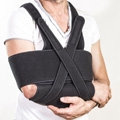The shoulder joint is one of the most mobile joints in the body and as a result is one of the most commonly dislocated. Young athletes participating in football and other contact or collision sports are particularly prone to experiencing a shoulder dislocation. Bracing may help stabilize a shoulder by limiting motion that would place it in a vulnerable position. While surgical management has had positive results regarding return to sport and decreased recurrent instability, it is often a season ending treatment for the athlete.1 Nonoperative management could be an option in select athletes wishing to return to in-season competition. Bracing contributes to pain control and supplements stability.2 There are three primary categories of action by which functional shoulder braces provide stability:
- Harnesses or straps that limit extension and rotation
- Indirect force on the shoulder
- Direct force on the shoulder3
Braces with harnesses or straps serve as a restraint and are inherently more motion limiting than braces that apply directed forces. Ideally, functional bracing serves to provide stability without limiting function. Unfortunately, functional bracing may hamper certain sport-specific skills, and therefore may not be applicable for all athletes. Specifically, motion limitation would be unfavorable for throwing or overhead athletes. Additionally, braces that provide directed forces might interfere with aerobic capacity and upper extremity motion. A variety of braces are available, and athletes should focus on which type best provides stability without inhibiting competition.
Following a traumatic dislocation, patients often continue to experience apprehension with arm extension and rotation. Functional bracing may serve as a useful tool to nonoperative management by means of limiting motion that places the arm in a vulnerable position. However, limitation of overhead activity may not be suitable for throwing or overhead athletes.
Consequently, athletes should focus on functional bracing that provides stability without sacrificing sport-specific skills and return to competition.














